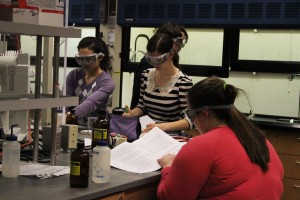By Kevin Hong
hongze@grinnell.edu
A surge of extra students is navigating the Noyce Science Center’s maze of corridors this year. Last semester in particular, the Biology and Chemistry Departments faced a spike in the number of students who registered for Biology 251, Molecules, Cells, and Organisms and Chemistry 221, Organic Chemistry I.
“We worked very hard to rearrange our schedule and added a whole section of BIO-251 with lab, and we shuffled the teaching schedule so that we could accommodate virtually every student who wanted to take those courses,” said Leslie Gregg-Jolly, Chair of the Biology Department. “There were a few who had a scheduling conflict, but we did make space for every person.”
Shannon Hinsa-Leasure, Biology, had to teach an extra section to accommodate more students.
“I got to teach an extra 251 section and we did that because we don’t want to over-enroll any of our classes,” she said. “We don’t want the class to pass its capacity. We are excited that we have so many people interested in science, and it’s really a good thing for a department to have students who are interested in their courses.”
Hinsa-Leasure said in some respects teaching two sections was not too difficult because she was teaching the same class twice, but she found it challenging to keep the classes moving at the same speed.
“I got more questions in one class and I tried to keep them at the same pace so that I was moving through the material in the same way,” she said.
Lab space was also tight last semester. One of the sections that Hinsa-Leasure taught had 26 students, above the normal capacity of 24 students.

“I did not want anyone to be cut from the class, so some people had to work at the back bench but they had suitable space,” she said. “We were lucky that we had support staff and a TA to help them and things all worked out,” she said.
The fall semester of sophomore year is widely seen as the hardest for certain science majors because it is has a heavy course load of organic chemistry and biology.
“The students tend to be stressed out, so I had a lot of stressed students to deal with,” Hinsa-Leasure said. “However, I got to teach the same class twice, but I had more students who needed things, so that probably equaled out my typical load.”
Students who take Biology 251 need to be co-enrolled in Chemistry 221, so Chemistry was in a difficult position as well. In fact, there were even more students enrolled in chemistry classes than in biology ones.
“What happened last semester was there was a much larger enrollment for Chemistry 221 than there ever had before,” said Mark Levandoski, Chair of the Chemistry Department.
In general, faculty members are happy to see that students are interested in sciences.
“I think it’s great,” Gregg-Jolly said. “I hope that they are taking a good liberal arts curriculum as well, not just loading up on the sciences. I think the liberal arts education is the best foundation for just about anything. I also feel that students in our courses are really here to learn, not just checking things off.”
Levandoski expressed a similar opinion.
“We want to teach these courses and be able to accommodate the students,” he said. “We love to have students interact with us. Also on behalf of the department, our behavior in the past few years has been with the idea that we want the students who want to take our courses because very rarely was a student cut from a class,” he said.
To better accommodate students’ needs, both the Biology and Chemistry Departments are making predictions about enrollment for next semester.
“This semester we did fairly well,” Gregg-Jolly said. “Every student who registered for BIO-150 got in, though not always the section that they wanted. Right now, we are able to accommodate but I would say we are close to the brink, especially with some of the pressures of the Biochemistry major, so we are paying close attention and we try to plan ahead.”
Levandoski is also positive in terms of scheduling courses better. “In our planning for next year, we were looking at what the enrollments are for Chemistry 129 and Chemistry 210, which are predominantly first-year students,” he said. “We did our best to predict, and we’ll see what happens next semester.”



















































